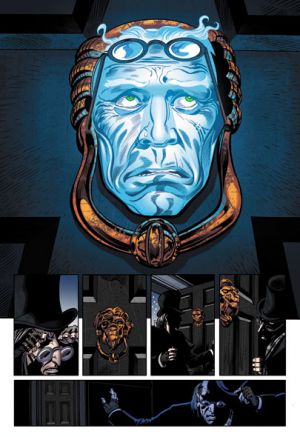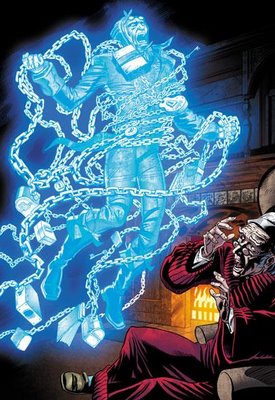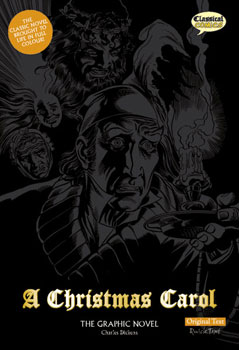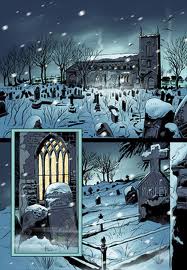Comics /
Spotlight /
Progressive Panels
A Christmas Carol
By Andy Frisk
December 22, 2011 - 15:19
Charles Dickens’ classic Christmas story has been told, reinterpreted, and adapted over the years by many, many writers, playwrights, filmmakers, artists, actors, and storytellers. Some of these interpretations are highly faithful to Dickens’ original message while others stray widely from the original text and intent of
A Christmas Carol. Two of my most recent encounters with Dickens’ tale involved a viewing of the recent Jim Carey driven
Disney’s A Christmas Carol, which was, while faithful to a point to the original material, a mixed experience at best. The other was a local playhouse’s adaptation of
A Christmas Carol to the stage. While much more enjoyable, as live theatre often can be, and faithful to the source material, Dickens’ central message was slightly re-written by taking the focus off of Scrooge’s inherent fatal flaw, his miserly and greedy obsession with hoarding coin, and instead making Scrooge a product of his environment. It was a subtle, but incredibly telling psychological and thematic change. While interesting from said psychological standpoint, it seriously recast Scrooge, and therefore his fatal flaw, in a much more sympathetic light. Based upon a reading of Dickens’ original text, Scrooge was not a product of his environment as much as a proponent of the rampant greed and proto-robber baron capitalism that ran rampantly unchecked in the 19th Century, and created a horrific gap between the rich and the poor. A poor who were regularly abused in order to supply those at the top with their wealth. Never more has a story highlighting the evils of driven and unchecked greed, and a greater and greater growing disparity between the 1% and the 99%, been as relevant as it is now. This is not so much because the 99% (in America) are all as desperate as the hard working Bob Cratchit (not by a long shot), but that the wealthy on Wall Street and in corporate boardrooms across the nation are so quick to potentially create an army of Bob Cratchit’s by ruining people’s lives through job cuts and a restructuring of their livelihoods in order to meet their bonus driven bottom lines and dividend payouts. We won’t even get into the sins of the Bernie Madoff-like robber barons. So, with
Disney’s A Christmas Carol being a mixed bag of messages that focused more on highlighting its 3-D chops and Halloween-like darkness, and stage productions like that mentioned above focusing on the nature vs. nurture theme, where (beyond the text itself and older productions of the story) is one to turn for a faithful interpretation? Well, this is a graphic novel centric site/column, so it shouldn’t surprise you that Classical Comics’ 2008 (and recently reprinted 2011) graphic novel interpretation of
A Christmas Carol is a likely place to find such an interpretation.
To begin with, as I have always said and will say again, no graphic novel (or “comic book”) interpretation of a classical work of literature will EVER serve as a stand in for the original work. There are things that one simply cannot learn from an interpretation of a work, no matter how well it is done, in comparison to the enlightening, intellectually stimulating, educational, and rewarding experience of reading the source novel. Often times when I take a look at “Classics as Comics,” the articles I write on them do very well with the internet public. I have to assume this is mostly because some of you students out there are looking for a way to get around reading the works assigned to you. Don’t do it. Read the work, then read the “comic book” or watch the movie. If you’re really smart, and want to impress your instructors or professors, then use the “comic book” interpretations of these works to ENHANCE and DEMONSTRATE how such works can shed new insights into the ORIGINAL text. Okay, my lecturing is done. Those who are not looking for a shortcut around reading the classics, and are truly interested in this intelligent interpretation of A Christmas Carol I apologize. I just felt that this was a necessary topic to address.
 |
Brilliantly adapted from the original prose by Sean Michael Wilson and lavishly illustrated by Mike Collins, David Roach, and James Offredi, Classical Comics’
A Christmas Carol is more faithful to Dickens’ original work than many screen interpretations (barring perhaps the George C. Scott starring television production with him in the title role). The main reason this is so is that Classical Comics actually produces two different versions of their classic literature adaptations, the better of which utilizes the original text and language of the source work. Nothing is more frustrating, and a disservice, to a reader than a dumbing down of the language of these works. Nothing is more frustrating to an admirer of such language as when one of Shakespeare’s plays gets adapted for a “modern” audience. I hate to break it to you “interpreters,” but Shakespeare’s English
IS Modern English. Anyway…ignoring the fact that Classical Comics does this too (their saving grace is that they do produce an original text adaptation as well), their “Original Text” adaptation of
A Christmas Carol uses Dickens’ original text, and it is by far the better edition. This is the reason that the original classics of literature are still taught using the
original texts. The language is meant to be stimulating and cause one to pause and reflect, and in certain circumstance, research the allusions and syntax for meaning. These exercises sharpen the mind and quicken the soul. The use of the original language, and an eschewing of re-writing scenes, or worse yet, adding scenes makes Classical Comics’
A Christmas Carol more accurate to the original than many screen and stage interpretations.
 |
This adaptation is a visual one though, so if the art didn’t match the prose adapter’s choice of words then the whole affair could have easily failed. The artistic team of Collins, Roach, and Offredi ensures that this is not so with their brilliant artwork and panel flow. This is what makes this interpretation so powerfully close to the original. Collins and company are obvious readers (and admirers) of Dickens’ original tale, and it shows in their artwork. Page for page and panel for panel Collins and company bring Dickens’ original and beautifully descriptive prose to highly detailed life. Yes, as my readers are well aware, I admire a sequential artist’s penchant for including detailed background work almost as much as I do their grasp of anatomy, choreography, and the like. Collins does and excellent job of bringing to life the backgrounds in his panels, especially those involving my personal favorite of the Three Spirits, The Ghost of Christmas Present.
It is the Ghost of Christmas Present who sums up the lessons of A Christmas Carol most succinctly, and the entire artistic and writing team on Classical Comics’ A Christmas Carol adaptation seems to realize this as Scrooge’s adventures with The Ghost of Christmas Present are the most detailed, prose packed, and alive pages in the entire work. They go to great lengths to bring to life the many varied scenes that The Ghost brings Scrooge along to witness, not just the Cratchit Family Christmas, as most adaptation of A Christmas Carol do. They also capture this Ghost’s parting scene, where he reveals the wretched children of mankind, Ignorance and Want, that scurry just behind the outward veneer of abundance and joy that The Ghost of Christmas Present exudes. The most powerful scene in A Christmas Carol is captured very well by Collins and company here.
Herein is the lesson of
A Christmas Carol, which is evident in any true adaptation that is. Men with the power to stave off the advance of Ignorance and Want, men like Scrooge himself, but instead decide to play God with their fellow men’s lives in order to line their pockets and maintain their status quo, a status quo that is so far beyond the average middle class family’s status quo as to be obscene—and unnecessary, are among the greatest of sinners. Scrooge isn’t this way because of any environmental conditions. Undoubtedly, he didn’t have an ideal childhood, but as he grew to be a man he witnessed too many instances of kindness and kept company with too many golden hearted fellows such as Old Fezziwig and Belle to be burdened eternally by his sad childhood. His personal and spiritual development witnessed as much kindness and cheer as it did avarice and sorrow. Scrooge made the choice to offer his soul to the demon of greed. Fortunately, he learned his lesson sooner than later, but many, especially today, are blind and deaf to this simple, oft repeated, at times corrupted, but originally enlightening tale's lesson. Perhaps a revisiting of the lessons of this tale would do some good. Classical Comics’
A Christmas Carol is a great example of an adaptation of the original tale that brings these lessons to vivid life. Many of these types of men and women (regardless of class) would benefit from a re-examination of them.
Like music? So does Andy. Read his thoughts on it here.
Rating: 10 /10
Last Updated: January 17, 2025 - 08:20



